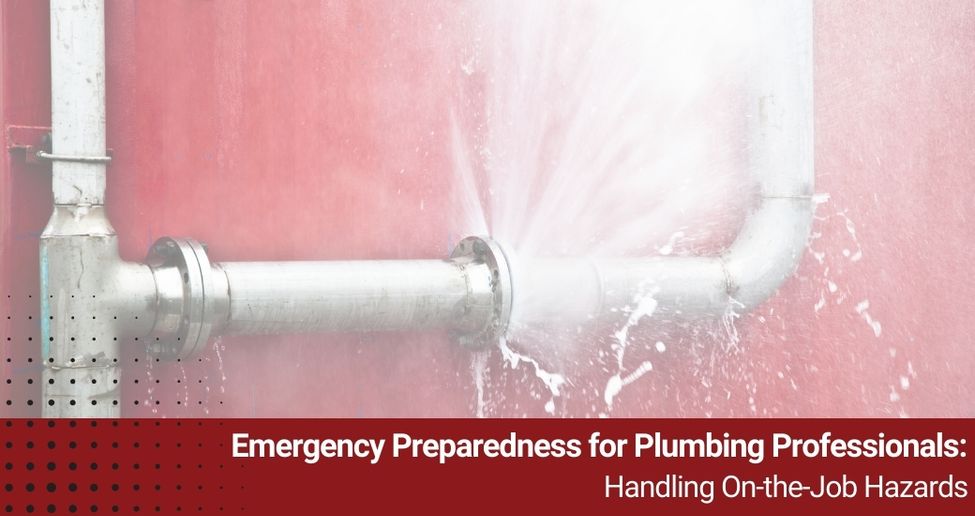Plumbing professionals often work in environments that expose them to various hazards. From water damage to gas leaks, the risks can escalate quickly if not handled properly. Emergency preparedness is crucial for plumbers to protect themselves, their clients, and their property. By understanding potential hazards and having a plan in place, plumbing professionals can navigate emergencies with confidence and efficiency.
Common On-the-Job Hazards in Plumbing
To prepare for emergencies, it’s essential to identify the most common hazards plumbing professionals face:
-
Water Damage: Burst pipes or leaks can lead to flooding and property damage, creating a hazardous work environment.
-
Gas Leaks: Working with gas lines carries the risk of leaks, which can result in explosions or carbon monoxide poisoning.
-
Sewage Exposure: Contact with raw sewage can lead to infections and illnesses caused by harmful bacteria and pathogens.
-
Electric Shock: Plumbing often intersects with electrical systems, posing a risk of electric shock or electrocution.
-
Confined Spaces: Crawl spaces, basements, and trenches can present oxygen deficiency or toxic gas buildup.
-
Chemical Exposure: Cleaning agents, adhesives, and sealants can irritate the skin, eyes, or respiratory system if handled improperly.
-
Slip and Fall Hazards: Wet or cluttered work areas increase the risk of slips, trips, and falls.
Creating an Emergency Preparedness Plan
A comprehensive emergency preparedness plan can make a significant difference in handling on-the-job hazards. Here are the key components of an effective plan:
1. Risk Assessment
Evaluate each job site to identify potential hazards. Look for issues such as:
-
Signs of structural instability in the work area.
-
Proximity to gas lines or electrical systems.
-
Access to proper ventilation in confined spaces.
2. Training and Education
Ensure all team members are trained to handle emergencies. Training should include:
-
Recognizing hazards like gas leaks or electrical risks.
-
Using personal protective equipment (PPE) correctly.
-
Administering first aid and CPR.
-
Familiarity with safety data sheets (SDS) for chemicals used on the job.
3. Communication Plan
Establish clear communication protocols for emergencies. This includes:
-
Assigning a point person to manage emergency response.
-
Creating a list of emergency contacts, including local fire, police, and medical services.
-
Using radios or mobile phones for immediate communication.
4. Access to Emergency Supplies
Equip your team with essential emergency supplies, such as:
-
First aid kits with bandages, antiseptics, and medical gloves.
-
Fire extinguishers rated for electrical and flammable materials.
-
Spill containment materials to manage chemical or sewage spills.
-
Flashlights and portable lighting for low-visibility situations.
5. Emergency Evacuation Procedures
Develop evacuation procedures tailored to different scenarios. For example:
-
In case of gas leaks, prioritize evacuating the area and shutting off the gas supply.
-
For water damage, locate and turn off the main water valve.
-
In confined spaces, have a standby team ready for rescue if needed.
Responding to Specific Plumbing Emergencies
Being prepared means knowing how to respond to various emergencies. Here’s a closer look at how plumbing professionals can address specific hazards:
1. Water Damage
-
Locate and turn off the water supply immediately.
-
Use pumps or wet/dry vacuums to remove standing water.
-
Place dehumidifiers or fans to dry the affected area and prevent mold growth.
2. Gas Leaks
-
Evacuate the area and advise occupants to leave the building.
-
Avoid using electrical switches, as they can trigger explosions.
-
Call the gas company and emergency services for assistance.
3. Sewage Spills
-
Wear proper PPE, including gloves, goggles, and waterproof boots.
-
Contain the spill using absorbent materials or barriers.
-
Disinfect the area thoroughly after cleanup.
4. Electric Shock
-
Shut off the power supply before starting work near electrical systems.
-
If an electric shock occurs, do not touch the injured person unless the power is off.
-
Administer first aid and call emergency services immediately.
5. Confined Space Hazards
-
Test the air quality for oxygen levels and toxic gases.
-
Use proper ventilation equipment, such as fans or blowers.
-
Always have a safety team on standby outside the confined space.
The Importance of Personal Protective Equipment (PPE)
Wearing the right PPE can significantly reduce the risk of injuries during emergencies. Essential PPE for plumbing professionals includes:
-
Gloves: Use nitrile or chemical-resistant gloves to protect hands from chemicals and sewage.
-
Safety Glasses or Goggles: Shield eyes from debris and chemical splashes.
-
Respirators: Protect against inhaling toxic fumes or particles.
-
Steel-Toed Boots: Prevent foot injuries from falling objects or sharp debris.
-
Hard Hats: Protect the head from falling objects or low-clearance spaces.
Staying Compliant with Safety Standards
Plumbing professionals must adhere to local and federal safety regulations to ensure a safe working environment. Key organizations and standards to be aware of include:
-
Occupational Safety and Health Administration (OSHA): OSHA provides guidelines for hazard communication, confined space entry, and PPE requirements.
-
National Fire Protection Association (NFPA): NFPA standards cover fire safety and electrical hazards.
-
American National Standards Institute (ANSI): ANSI establishes safety equipment standards, including those for gloves and eyewear.
Developing a Culture of Safety
Promoting a culture of safety within your plumbing team is essential for long-term success. Encourage the following:
-
Open Communication: Create an environment where team members feel comfortable reporting hazards or concerns.
-
Regular Safety Meetings: Conduct meetings to review safety protocols and discuss recent incidents or near misses.
-
Continuous Improvement: Regularly update your emergency preparedness plan based on new risks or feedback from the team.
Conclusion
Emergency preparedness is a vital aspect of the plumbing profession. By identifying potential hazards, equipping teams with proper training and PPE, and implementing a solid emergency plan, plumbing professionals can confidently handle on-the-job risks. Prioritizing safety not only protects workers but also enhances the quality and reliability of their services. In a field where hazards can arise unexpectedly, being prepared is the best defense against emergencies.

